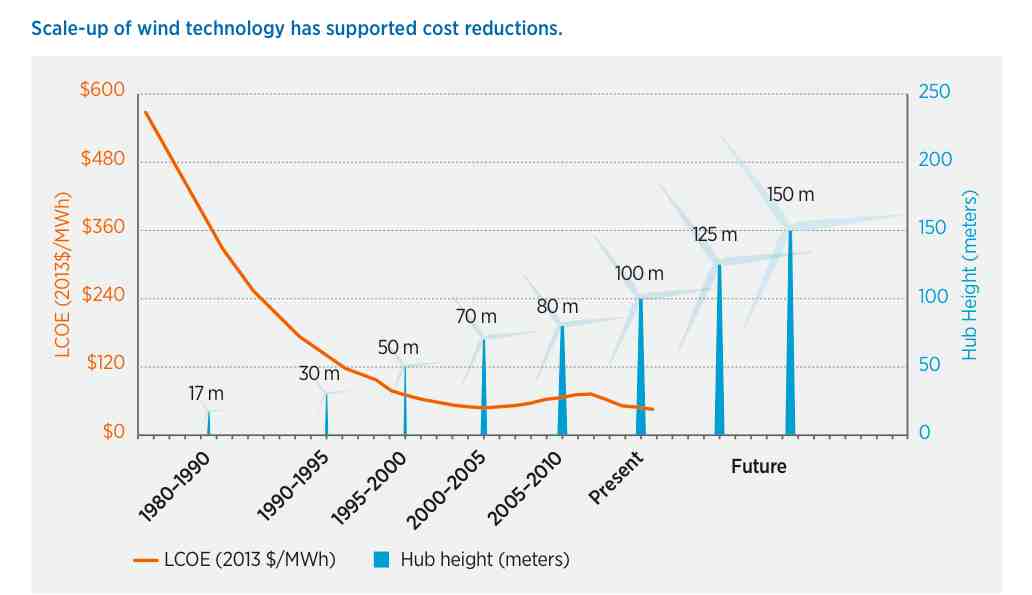The Obama administration says wind energy could supply 35 per cent of the nation’s electricity by 2050, and says that within 10 years wind energy will be competitive even with existing coal plants.
The prediction is included in the US Department of Energy’s Wind Vision, a new era for wind energy in the US. It is an update of a document first released in 2008 by the Bush administration
In the latest version, the DoE says the current level of wind energy in the US – 4.5 per cent – is likely to double by 2020, before doubling again to 20 per cent of total demand by 2030.
The report predicts 35 per cent wind energy by 2050 as its core scenario, but says if wind costs are lower than expected, the result could be 41 per cent wind energy by 2050 – and this appears to be without assumed demand reductions from energy efficiency measures.
The DoE says a 35 per cent contribution from wind energy will reduce emissions, clean up the environment, reduce bills, and remove fuel price risk. It says wind energy, even with the costs of integration, will save 2.3c/kWh off the energy bills of consumers under the 2050 scenario, or a total of $280 billion.
The DoE says the 2050 will deliver cumulative benefits of $400 billion in avoided damage from greenhouse gases, and further benefits of $108 billion from avoided emissions of fine particulates and nitrogen oxides and sulfur dioxides.
The public health benefits amount to 0.9c/kwh of wind. And it will reduce water consumption by 23 per cent, create around 600,000 jobs, and deliver around $1 billion a year to farmers and other land holders in lease payments.
The DoE also noted a study on four rural counties in west Texas that found cumulative economic activity resulting from wind investments in local communities to be nearly $520,000 (in 2011 dollars) per MW of installed capacity over the 20-year lifetime of the wind plant.
To get to 35 per cent of total electricity demand by 2050, around 404GW of wind energy will need to be constructed, up from 61GW in 2013. That will take up around 1.5 per cent of US land, although almost all of this would be farm land available for other uses. Around one quarter will be sited offshore.
The report says in an “increasing number” of US markets, wind energy is already the cheapest source of new energy available, with the levellised cost of electricity in the best areas falling by one third in the past five years to $US45/MWh. (This includes access to transmission, as well as capital and balance of system costs).
And, in a further rebuff to those – particularly pro-nuclear advocates – who say that intermittent renewables add unspeakable amounts of so called “system costs”, the US Department of Energy says: “Wind generation variability has a minimal and manageable impact on grid reliability and related costs.”
The pro-nuclear lobby has launched a major campaign seeking to paint wind and solar as expensive because of system costs. Mostly, it cites its works produced by their own industry boosters.
The US DoE, however, says real-life experience proves quite the opposite. It notes two states, Iowa and South Dakota, sourced more than 25 per cent of their demand from wind in 2013, and seven others more than 12 per cent.
“Power system operators who have experience with wind now view its use routinely as a dependable component in the portfolio of generating options,” the DoE noted.
This is certainly the experience of South Australia, which now sources as high a ratio of wind energy (around 35 per cent) as the US aims for in a few decades time.
That wind energy has been absorbed into the system with minimal cost and disruption, apart for causing reduced revenues for centralised baseload generators. Both coal and nuclear are impacted by growing amounts of renewables, and both coal and nuclear share a common interest in seeing renewable energy penetration capped at low levels.
A new study released by the Australian Renewable Energy Agency this week noted that solar PV, for instance, could provide 60 per cent of demand even in a small grid such as that around Alice Springs. It noted that such grids already accommodate numerous, and because of this intermittent renewables can be easily absorbed.
In the US, the National Renewable Energy Laboratory said in a report last year that wind energy can actually increase grid reliability. In a separate 2012 study, it showed that the US could obtain 80 per cent of its electricity from renewables by 2050 in part because every corner of the country would be able to generate power from renewables, not just the sunniest, windiest places.
Indeed, the Obama Adninistration also has a Solar Sunshot program, where it aims to make solar as cheap as existing fossil fuels by 2020. According to many analysts, it is already cheaper than baseload and peaking gas plants.













